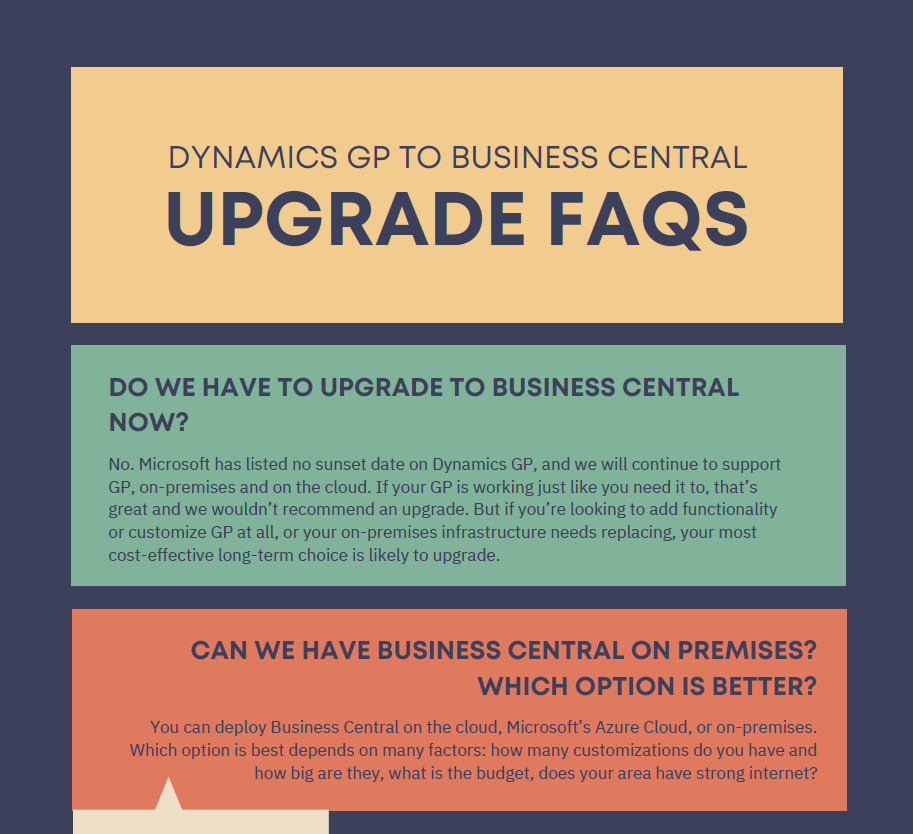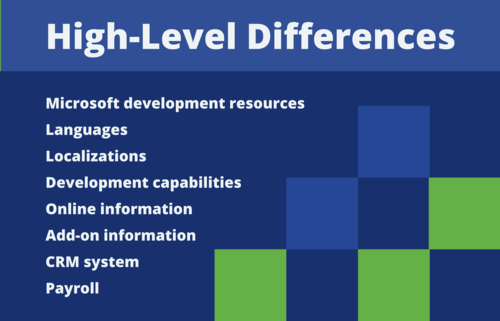What are the high-level differences between Dynamics GP and Business Central?
Recently, our very own Syvantis CEO, Janelle Riley, began a video series tackling this big question: What, exactly, is the difference between Dynamics GP and Business Central?
If you have wondered this very thing, you’ve come to the right place. Janelle’s video series will cover just this question, the all-important, I’m already on GP. Should I migrate from GP to Business Central?
If you’re reading this, you’re likely already looking into these questions and have realized that the answers are complex and nuanced, and definitely not something you want to (or should have to) figure out alone. That’s the whole point behind the video series, the first video of which we’ve included below. This episode is all about high-level differences, and in future videos, we’ll get to more granular details. We invite you to watch it, and we’ve compiled the major takeaways of the video below.
YouTube video: Every little difference between Dynamics GP and Business Central.
Microsoft development resources
Dynamics 365 Business Central is Microsoft’s next generation cloud application and is the focus of Microsoft’s developmental resources. They’ve decided where they want their energy and excitement to go, and it’s with Business Central. Why? That’s a long story we’ve covered in a blog series, but the short story is: Dynamics GP will soon be a legacy ERP solution.
What does “legacy” mean? Well, if you currently use GP, you’ve likely noticed it hasn’t changed much in quite a while. There’s one upgrade a year, and in that upgrade there may be a few new features and some bug fixes, but that’s it. If you’re thinking, “Good. I don’t want it to change,” think about it a different way – while the world continues to forge on, GP will not. Let’s be clear on this, though: Microsoft is still supporting Dynamics GP and has no current plans to change that.
While GP is receiving just basic updates once a year, Business Central is constantly being developed, with 2 substantial feature upgrades each year and monthly updates.
Languages and localizations
Business Central was originally developed in Europe and has a worldwide presence, meaning more languages and localizations available for Business Central than Dynamics GP.
What we mean by “language” is exactly what you’d expect – a translation of the solution into a target language. While GP has three available languages – English, French, and Spanish – Business Central is available in thirteen languages by default and many partners provide additional languages as well.
“Localization” is a little less clear. A localization is a modification to the system in order to follow local accounting rules and laws. Languages and localizations overlay each other in the system and are dependent on the business’ needs and preferences, such as their headquarter location and language and wherever they do business. For instance, a business may be delivered in Spanish and have an American localization with US GAAP rules.
Thinking about moving from Dynamics GP to Business Central?
We’ve got the answers to our most frequently asked questions
in this handy (and free) infographic.
Development capabilities
This is a big one. There’s a complex nature to customizations and modifications in Dynamics GP. Consider GP a rigid sort of black box. It is what it is, and changing it—for instance adding a field—requires buying add-ons and having a partner make the changes you want, all of which is a timely and complex process that adds to your overhead. And though you exert all that time, money, and effort, the change is obvious and slightly clunky, requiring extra clicks and popup windows for data entry.
The contrast is stark with Business Central. The underlying architecture allows for robust, fast, versatile development within your Business Central environment, and your partner will have a developing team who will be able to add a field—to return to our previous example—anywhere on the screen that you want in literally minutes. There’s really no competition when it comes to development on Business Central.
Online information
Dynamics GP has a strong blogging community supporting the application. This is due to its seniority (it’s been around for a while) and because it was originally developed in the US. You can find detailed information about most error messages and steps to fix the issue. This luxury of online info is not available with Business Central—yet. The Business Central online blogging community is rapidly growing, but for the time being, it’s small and an error search may end in zero or inaccurate results. This means leaning on your partner a bit more.
Add-ons
Another boon of Dynamics GP’s seniority is its rich ISV (Independent Software Vendor, or add-on) community. There are a ton of apps out there, and some are great. But finding the right add-on vendor for your needs has always been a matter of relying on your partner. There’s more transparency and availability of Business Central add-ons via Microsoft’s AppSource approved vendor portal. Right now, there are over 1,800 applications on AppSource, and many of the GP ISVs that you know and love have been rewritten for Business Central. There’s still the matter of checking in with your partner about which of those 1,800 apps will be best for you, but it’s no longer that opaque process.
CRM
Basic Customer Relationship Management (CRM) is built-into Business Central but absent from Dynamics GP. In Business Central, you can track accounts, contracts, opportunities, and the basic info funnel without hassle. If that’s all your organization needs – great!
But what if you need more? What if you need to manage prospects and leads along the sales pipeline? We’ve said it before and we’ll say it again: the true beauty of the Dynamics 365 suite of business applications, of which Business Central is part, is their ability to integrate and work together. If you’re organization needs more robust CRM capabilities and you’re using Business Central, you can use another solution—Dynamics 365 Sales—that is made to work with Business Central, shares a similar interface, and is fully customizable for your sales team.
Payroll
It may feel like a blow to Business Central that there is no payroll module; however, there are several payroll apps on AppSource that Syvantis’ customers have stated are better solutions than Dynamics GP’s built-in payroll solution. Just because it’s not out-of-the-box doesn’t mean it can’t be added to even greater effect.
Learn more or start your journey
The next episode of this video series will dig into the many terminology differences between Dynamics GP and Business Central. With more clarity of language, you will find it easier to compare the two solutions and make strong business decisions. Keep an eye out for future episode of the series on our YouTube channel.
Are you ready to begin your journey with Business Central? We are happy to help you! Click the button below to connect with our skilled ERP consultants, see a demo personalized to your business process needs, and find out if Business Central is the right choice for your business.




